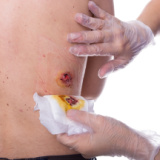What is a Powdery Mildew?
- A skin growth or a lump that grows if left untreated.
- A stain is an accumulation of dirt in the pouch.
- May have a foul odor
- Can be red, swollen and painful.
- It will not heal without surgery.
It is easy to understand if you think of it as "a condition in which the navel's outlet is blocked and the navel is buried in the body. The navel is filled with dirt called sesame. This is the result of old skin that has been removed by metabolism, and it is also the source of the bad odor. Normally, this is washed off in a bath and that is the end of it. However, when the navel is buried in the skin and there is no way out, the plaque builds up and smells bad.
1. what is a powdery mildew? Causes and early symptoms
2. those who are prone to form
3. almost no spontaneous healing
4. it is getting painful This means that it was left untreated to an inflammatory powder.
Is surgery the only way to cure it?
What are the costs of treatment? Can I get surgical benefits?
7. how to recognize it Can it be a malignant cancer?
8. I have problems with the buttocks, groin, pubic area, base of the legs, and groin.
9. other lumps I can't tell the difference from other lumps
Schema Video
An atheroma/atheroma is "a mass formed when the epithelial components of the skin (epidermis and outer hair follicle sheath) fall into and under the skin to form a pouch, in which gruel-like plaque or fat is stored." and the website of the Japanese Society of Plastic Surgery (The Japanese Society of Plastic and Reconstructive Surgery (jsprs.or.jp)The following is explained in the following section.
1. What is a powdery mildew? Causes and early symptoms
A bump is a lump on the skin (subcutaneous tumor) that can appear anywhere on the body and is not cancer. They are not really fat, but rather a pouch-like structure just under the skin where plaque (keratin) and skin oil (sebum), which should be shed from the skin, accumulate without being shed.
The initial symptoms are only noticeable as darkened pores, and a slight lump can be palpable when touched closely. If left untreated, the lump will grow in size as an elevated hemispherical mass. The lumps adhere closely to the skin and are harder to the touch than their surroundings.
The cause of occurrence is unknown. It may occur after bruising or trauma, or in acne scars. Medically speaking, they are clumps of intradermal and subcutaneous epithelial components of the skin (epidermis and outer follicular sheath) that fall into the skin and form pouches in which gruel-like plaque and oil are stored.
2. people who are prone to forming
Some people are more prone to develop them, often on the back, the nape of the neck, or on the cheeks and earlobes of the face. However, it is not known which people are more prone to the formation of these lesions.
3. spontaneous healing is unlikely.
It rarely disappears spontaneously, and if left untreated, it can gradually grow to over 10 cm in size. We recommend surgical removal as soon as it is noticed and before it becomes painful. In most cases, it will heal completely within a few days of a doctor's visit.
4. When it hurts: ...... When it has been left untreated to an inflammatory powdery mildew
When a bacterial infection occurs, it suddenly becomes large, red, swollen, and painful, and may be mistaken for a "pimple. Many patients come to our office saying, "I have had a feeling of discomfort for a few days, but if I leave it untreated, it suddenly became large and painful yesterday. If left untreated further, the skin will break open and discharge pus and a smelly porridge-like mass. If pressure is applied forcibly to remove the pus when it is red and swollen, the sack may break and scatter into the fatty fabric, resulting in a condition called pyoderma. Do not try to force the contents out by applying pressure, and consult a physician as soon as possible for medication and treatment. It does not take long for the area to go from mushy to painful and swollen. If you see a doctor in this state, it may take several weeks to fully heal, and you will regret it.
5. the cure is a simple surgery
In plastic surgery, newly graduated surgeons first learn to operate on a bunion, a surgical procedure that has remained unchanged for more than 40 years, with the following two surgical methods being used. Each has its advantages and disadvantages, and neither is superior to the other. The time required is almost the same. It is best to leave the method to the doctor.
Spindle-shaped incision surgical photograph
A spindle-shaped incision is made in the skin directly above the mass, the mass is removed, and sutures are applied.
Pros: can handle larger sizes. Higher likelihood of complete removal and lower recurrence rate.
Cons: Leaves a scar the length of the powder diameter
Surgical photo of the hollowing out method
This method involves drilling a small round hole in the skin and pulling the powder out through it.
Pros: The scar after treatment is small. For facial masses, the spindle-shaped incision may be tried first, but even on the face, depending on the area and size, the spindle-shaped incision may be less noticeable.
Cons: Although it is necessary to hollow out the powdery mildew, including its small exit, in some cases it is difficult to see the exit. Also, since the pouch is pulled out through a small hole, it is difficult for the doctor to notice if part of the mass remains because it is not visible. In both cases, they recur.
Appropriate surgery is determined after examining the patient.
Surgery to reduce pain (thin needles, Meylon for anesthesia)
day surgery
covered by insurance
Short time, no noticeable scarring
What are the costs of treatment? Can I get surgical benefits?
The cost is the same for the spindle-shaped excision and the hollowed-out excision. The cost will vary depending on the location and size of the growth. In addition to the surgery fee, an examination fee is required. For insurance treatment, the fee is the same throughout Japan.
Table of Costs
Surgical Benefits
If you have medical insurance from a life insurance company or mutual aid association, you may be eligible for surgical benefits. Please note that the benefit will not be paid unless the person himself/herself completes the procedure. Usually, the doctor will fill out a form designated by the insurance company. If you are a member of a life insurance company or mutual aid association, please check with the insurance company.
7. how to tell if it is a malignant cancer?
The characteristics of a powdery mildew include the following
- Slightly raised skin, lumps of several millimeters to several centimeters
- There is a black dot (opening) in the center of the lump
- Sometimes something with an odor comes out.
- Not painful or itchy, but inflamed, red, swollen and painful
- If the inflammation is left untreated, it will rupture and pus will form.
Basically, if the pouch is not removed cleanly, the mass will recur. It has been reported that if left untreated and repeatedly inflamed, they can become cancerous (cancer), but this is rare, and few plastic surgeons with over 30 years of experience have ever seen a patient with a mass that turned into cancer. (Seehttps://www.ncbi.nlm.nih.gov/pubmed/29681810)
8. painful sores or boils on my hips, groin, pubic area, base of legs, and groin
It is important to note that painful lesions in these areas are often not molluscum contagiosum. A skin disease called pyogenic hidradenitis is more likely to occur on the buttocks, the groin area, the armpits, the lower part of the breasts, and the perianal area. Antibiotics (anti-pus medication) alone do not cure the disease, and surgery to remove the affected area with a scalpel is often required. In severe cases, biological agents may be taken. The cause is unknown in many respects and is said to be related to heredity, smoking, obesity, bacteria, mechanical irritation, and hormones. The distinction from a powdery mass can be clarified by having an ultrasound echo examination.
If the sores are on the pubic area, people are embarrassed to seek medical attention and are reluctant to see a doctor until they become severe. They often appear on the area where the elastic of underwear touches the skin. If it is in the early stages, it can be easily treated, so please come to see us as soon as possible.
Stages and Severity of Pyogenic Hidradenitis (kingslun.com) Journal of the Japanese Dermatological Association, Vol. 131, No. 1 (jst.go.jp)
9. other lumps I can't tell the difference from other lumps
They include calcified epithelioma, lipoma, ganglion, sebaceous cysticercosis, dermoid cyst, schwannoma, and preauricular fistula. Other rare malignant conditions include cancer (carcinoma). They are easily distinguished by a physician, but are difficult to explain to a patient in a way that he or she can understand.
To learn more, please click on the following link
calcified epitheliomaCalcifying Epithelioma|The Japanese Society of Plastic and Reconstructive Surgery (jsprs.or.jp)
Lipoma,Lipoma|The Japanese Society of Plastic and Reconstructive Surgery (jsprs.or.jp)
ganglion5gangurion.pdf (jssh.or.jp)
Sebaceous cysticercosis,
dermoid cystJapanese Society of Plastic and Reconstructive Surgery (jsprs.or.jp)
schwannoma
preauricular fistulaEustachian Fistula (Anterior) / The Japanese Society of Plastic and Reconstructive Surgery (jsprs.or.jp)
Powdery mildew can appear anywhere on the body. When they occur on the face, they can be mistaken for acne.
If you press hard, a smelly white substance may come out from inside. The mass grows little by little. When accompanied by inflammation, it suddenly becomes large, red, and painful.
It does not heal even if I crush it. It will soon swell up again. There is no treatment other than surgery.
It does not heal spontaneously. After it becomes inflamed and painful, treatment is prolonged and the likelihood of recurrence increases.
There is no cure other than complete removal of the powdery mildew by surgery. It is a day surgery and usually does not require hospitalization.
Inflammation, swelling, and pain require same-day treatment to relieve pain.
If the patient is pain-free, he or she will be asked to make an appointment for surgery at a later date.
The injection of local anesthesia is slightly painful. For patients who are sensitive to pain, an anesthetic cream to be applied and a specially thin needle can be used to relieve pain. Once the anesthesia is administered, there is no pain during the surgery. After the surgery, oral pain medication is prescribed in case of pain after the anesthesia wears off.
A doctor's visit the next day or two is required. Stitches are usually scheduled to be removed within a week, but it depends on the medical condition. Patients who undergo surgery after inflammation and pain tend to require more frequent hospital visits.
If you are diagnosed with a powdery mildew, the treatment is covered by insurance. Surgical benefits will be handled by providing the name of the disease and the surgery code to your insurance company. Please ask at the hospital reception desk for the surgery code.
Depending on the amount of alcohol consumed, it may be advisable to stop drinking on the day of the event.
On the day of surgery, it is advisable to avoid warming up the body, such as taking a bath. From the next day, showering is fine. However, each patient's condition is different, so please check with your doctor.
It depends on the surgical site. In general, it is best to avoid exercise for a few days. Be sure to check with your doctor.
Rarely, recurrence may occur. In the hollowing-out method, the wounds are small and the doctor cannot check with the naked eye whether they have been completely removed, so the possibility of recurrence tends to be higher than in the incision method.
Unfortunately, there is no surgery that does not leave scars. Plastic surgeons strive to create scars that are as inconspicuous as possible. Even with incisions, scars are designed to follow the creases in the skin so that they are not noticeable.
Scars heal in 1-2 weeks, but it may take several months before the scars are no longer noticeable. There are individual differences. Inflammatory masses, however, may take longer.
If it is a powdery mass, it should be treated in the same manner as above. A boil on the pubic area or buttocks is often not a powdery mass and should be diagnosed by a physician.
If diagnosed as a powder mass, the treatment is covered by insurance
If insurance covers 30% of the cost, the payment will be about 4,000-13,000 yen. The cost will vary depending on the size and location. In addition to the surgery fee, consultation, treatment, prescription, and examination fees will be charged separately.
People who are prone to powdery mildewSee also.







